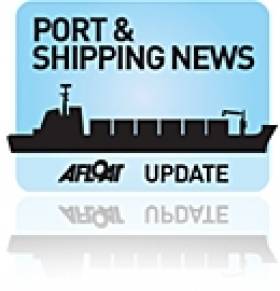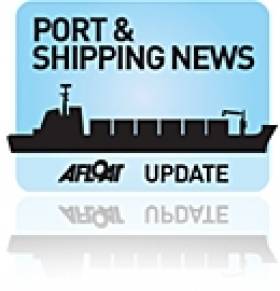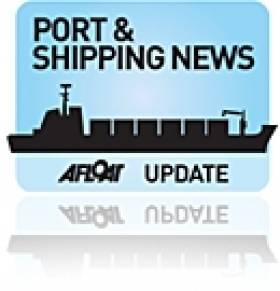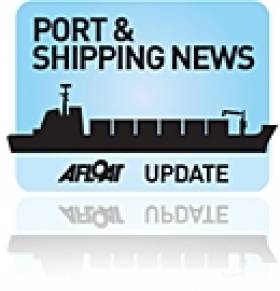Displaying items by tag: Guinness Tanks
Guinness ‘Made of More’ Tanks Make Another Appearance
#GuinnessTanks - The current Guinness TV advert campaign 'Made of More' is apt given additional fermentation tanks bound for St. James Gate Brewery in central Dublin, arrived by cargoship to Dun Laoghaire Harbour late last month, writes Jehan Ashmore.
To recap, Diageo began last year a €153m upgrade to refurbish the historic city-centre brewery, however due to low-bridge heights restrictions, this led to use of alternative roads to transport the cylinder-shaped tanks from Dun Laoghaire Harbour instead of Dublin Port.
This latest batch of stainless steel fermentation tanks on board Wilson Goole (1995/2,446grt) are understood to each weigh up to 30 tonnes. The previous 'project' cargo unloaded in Dun Laoghaire was during late 2013 and was tasked to Thamesteel I (1989/1,984grt) see report HERE, which features a telescopic wheelhouse and she departed directly from Rotterdam.
On this occasion, Wilson Goole also departed the Dutch port but her route included en route call to Follafoss, Norway followed by a short-cut through Scotland involving a transit of the Caledonian Canal. Upon arrival to Dun Laoghaire she docked at the Carlisle Pier.
The Norwegian operated vessel also features a telescopic bridge which overlooked four of the six cylinder tanks mounted as deck-cargo while the remaining two were stowed in the hull. For drawings of the vessel's cargo-hold layout, click here.
The majority of the project's tanks where handled in 2013 during a spate of deliveries to Dun Laoghaire Harbour in which three shipments docked between mid-February to late March.
In that timeframe, Blue Tune (2010/3,845grt), Keizersborg (1996/6,142grt) and Myrte (2008/6,120grt) also berthed at the Carlisle Pier. Following unloading of the tanks, their final leg of the journey to reach the brewery involved night-time convoy operations to minimise disruption and avoid traffic congestion.
Blue Tune's call in 2013, represented the return of cargoship trading activity after an absence in the harbour of more than two decades.
At the moment the port has no other commercial customers, until Stena Line as previously reported resume sailings over the festive and new year periods.
Not Quite the Full Pint as Further Tanks Arrive for Guinness Plant
#GuinnessTanks - Loaded with fermentation tanks for Guinness, Thamesteel I (1989/1,984grt) picked up a pilot in Dublin Bay as she approached Dun Laoghaire Harbour this evening, writes Jehan Ashmore.
It transpires that this extra shipment of the stainless steel fermentation tanks weighing up to 30 tons each are required for the €153m plant upgrade at the Guinness St. James's Gate Brewery facility in central Dublin.
Thamesteel I had sailed from Rotterdam-Maasvlakte from where previous shipments were discharged by a trio of cargoship's earlier this year, the last been Blue Tune which called to Dun Laoghaire Harbour in March.
On this occasion, the Marshall Islands flagged vessel which features a telescopic wheelhouse was raised due to the large cylindrical tanks positioned as deck cargo on the cargo hatch covers.
She berthed at Carlisle Pier from where the pilot was transferred back to the Camac, a Dublin Port pilot cutter built by Cork Harbour based Safehaven Marine.
Ports & Shipping Review: Cattleship Reaches Libya, Another Round of Guinness, Duke Visits Dublin, ShortSea '13, New Cork Port Chairman and more…
#ShippingReview – Over the last fortnight, Jehan Ashmore has reported from the shipping scene, where the trade in live-cattler exports to Libya, not seen since the mid-1990's, finally reached conclusion when livestock-carrier Express I docked in Misrata.
The 'ghost' ship Lyubov Orlova, which broke its tow-line in the Atlantic and believed to have possibly sunk, is a sister of the first ever cruiseship caller to Drogheda Port last year.
The Royal Navy's Type 23 Duke Class frigate HMS Richmond (F239) which has a displacement of 4,900 tonnes made a weekend courtesy call to Dublin Port.
A sister of the frigate which featured in a Bond movie starring Pierce Brosnan, by coincidence passed Dalkey on the same day, where the Irish actor was on location for a TV advert.
Next week, on Thursday (14 March), the European Shortsea Conference 2013 is to take place for the first time in France.
A new chairman for the Port of Cork Company, businessman John Mullins has been appointed by Minister of Transport Leo Varadkar.
Another round of Guinness fermentation tanks arrived into Dun Laoghaire Harbour, where Sunday strollers watched as the cargoship Keizersborg (1996/6,142grt) docked at the old 'mail' boat pier.
Commissioners of Irish Lights ILV Granuaile (2000/2,625grt) an aids to navigation tender vessel, is undergoing steel modification works by Arklow Marine Services while berthed in Dublin Port.
The 5 April is the deadline for members of the public to the Department of Transport, regarding plans to merge Bantry Bay Harbour with the Port of Cork Company.
The Irish Continental Group (ICG) parent company of Irish Ferries, have released a statement of results for the year ended 2012.
A new container sea-rail-freight service between Waterford Port (Belview) and Ballina, Co. Mayo began operating to link in with sailing schedules by DFDS Logistics vessels running to Rotterdam.
Second Round of Guinness Tanks Arrive
#GuinnessTanks – Another shipment of Guinness fermentation tanks arrived into Dun Laoghaire Harbour, where Sunday strollers watched the cargoship's arrival, from the length of the East Pier, writes Jehan Ashmore.
On this occasion, cargoship Keizersborg (1996/6,142grt) operated by Dutch owners Wagonborg Shipping, berthed at Carlisle Pier. This is the second delivery of the 'project' cargo, with another batch due of the stainless steel cylinders, each weighing 30 tons.
They are bound for St. James's Gate Brewery, where the plant is undergoing a major upgrade costing €153m.
As previously reported, the first shipment was transported on board Myrte (2008/6,120grt) which too had sailed directly from the same Dutch port.
Also in port was the HSS Stena Explorer, which after the cargoship's docking, departed for Holyhead, so to complete the return leg of the daily operated single round-trip service.



























































